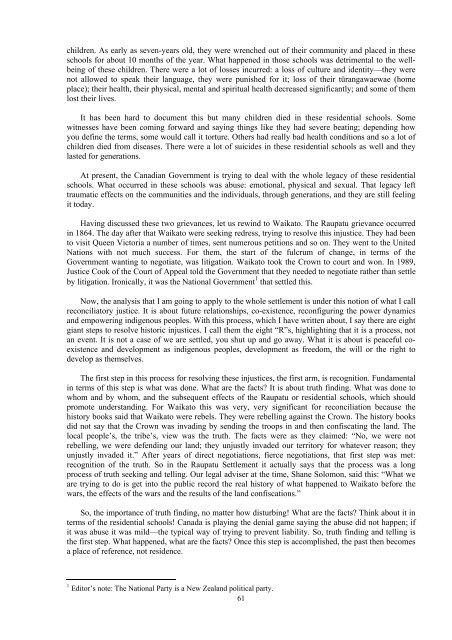traditional knowledge conference 2008 te tatau pounamu
traditional knowledge conference 2008 te tatau pounamu
traditional knowledge conference 2008 te tatau pounamu
Create successful ePaper yourself
Turn your PDF publications into a flip-book with our unique Google optimized e-Paper software.
children. As early as seven-years old, they were wrenched out of their community and placed in theseschools for about 10 months of the year. What happened in those schools was detrimental to the wellbeingof these children. There were a lot of losses incurred: a loss of culture and identity—they werenot allowed to speak their language, they were punished for it; loss of their tūrangawaewae (homeplace); their health, their physical, mental and spiritual health decreased significantly; and some of themlost their lives.It has been hard to document this but many children died in these residential schools. Somewitnesses have been coming forward and saying things like they had severe beating; depending howyou define the <strong>te</strong>rms, some would call it torture. Others had really bad health conditions and so a lot ofchildren died from diseases. There were a lot of suicides in these residential schools as well and theylas<strong>te</strong>d for generations.At present, the Canadian Government is trying to deal with the whole legacy of these residentialschools. What occurred in these schools was abuse: emotional, physical and sexual. That legacy lefttraumatic effects on the communities and the individuals, through generations, and they are still feelingit today.Having discussed these two grievances, let us rewind to Waikato. The Raupatu grievance occurredin 1864. The day af<strong>te</strong>r that Waikato were seeking redress, trying to resolve this injustice. They had beento visit Queen Victoria a number of times, sent numerous petitions and so on. They went to the Uni<strong>te</strong>dNations with not much success. For them, the start of the fulcrum of change, in <strong>te</strong>rms of theGovernment wanting to negotia<strong>te</strong>, was litigation. Waikato took the Crown to court and won. In 1989,Justice Cook of the Court of Appeal told the Government that they needed to negotia<strong>te</strong> rather than settleby litigation. Ironically, it was the National Government 1 that settled this.Now, the analysis that I am going to apply to the whole settlement is under this notion of what I callreconciliatory justice. It is about future relationships, co-exis<strong>te</strong>nce, reconfiguring the power dynamicsand empowering indigenous peoples. With this process, which I have writ<strong>te</strong>n about, I say there are eightgiant s<strong>te</strong>ps to resolve historic injustices. I call them the eight “R”s, highlighting that it is a process, notan event. It is not a case of we are settled, you shut up and go away. What it is about is peaceful coexis<strong>te</strong>nceand development as indigenous peoples, development as freedom, the will or the right todevelop as themselves.The first s<strong>te</strong>p in this process for resolving these injustices, the first arm, is recognition. Fundamentalin <strong>te</strong>rms of this s<strong>te</strong>p is what was done. What are the facts? It is about truth finding. What was done towhom and by whom, and the subsequent effects of the Raupatu or residential schools, which shouldpromo<strong>te</strong> understanding. For Waikato this was very, very significant for reconciliation because thehistory books said that Waikato were rebels. They were rebelling against the Crown. The history booksdid not say that the Crown was invading by sending the troops in and then confiscating the land. Thelocal people’s, the tribe’s, view was the truth. The facts were as they claimed: “No, we were notrebelling, we were defending our land; they unjustly invaded our <strong>te</strong>rritory for wha<strong>te</strong>ver reason; theyunjustly invaded it.” Af<strong>te</strong>r years of direct negotiations, fierce negotiations, that first s<strong>te</strong>p was met:recognition of the truth. So in the Raupatu Settlement it actually says that the process was a longprocess of truth seeking and <strong>te</strong>lling. Our legal adviser at the time, Shane Solomon, said this: “What weare trying to do is get into the public record the real history of what happened to Waikato before thewars, the effects of the wars and the results of the land confiscations.”So, the importance of truth finding, no mat<strong>te</strong>r how disturbing! What are the facts? Think about it in<strong>te</strong>rms of the residential schools! Canada is playing the denial game saying the abuse did not happen; ifit was abuse it was mild—the typical way of trying to prevent liability. So, truth finding and <strong>te</strong>lling isthe first s<strong>te</strong>p. What happened, what are the facts? Once this s<strong>te</strong>p is accomplished, the past then becomesa place of reference, not residence.1 Editor’s no<strong>te</strong>: The National Party is a New Zealand political party.61
















